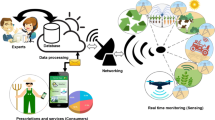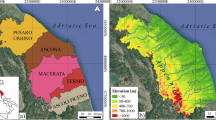Abstract
Wireless sensor networks (WSN) are a very promising technology in agriculture. Application of WSN in apple orchards could improve the data collection and precision farming level of the Chinese apple planting industry. WSN nodes communicate with each other via wireless signals. Prior knowledge of coverage range and attenuation speed is necessary for WSN deployment and application. Most of the existing empirical propagation models do not contain environmental parameters. However, leaf density and apple size change with time in apple orchards from spring to winter. An empirical model was created through a large number of measurements. Two parameters related to the environment were considered: the leaf area index and the apple size. Validation results showed that most of the determination coefficients (R2) were larger than 0.9 and most RMSE values were smaller than 5. The new model was suitable for estimating the path loss in apple orchards. Simulation experiments were conducted to evaluate the performance of the new model on energy conservation in the WSN application. Simulation results indicated that energy consumption could be reduced by 82, 45, and 39 % when the antenna height was 1, 2 and 3 m respectively.



















Similar content being viewed by others
References
Al-Basheir, M. S., Shubair, R. M., & Sharif, S. M. (2006). Measurements and analysis for signal attenuation through date palm trees at 2.1 GHz frequency. Sudan Engineering Society Journal, 52(45), 17–22.
Al-Nuaimi, M. O., & Stephens, R. B. L. (1998). Measurements and prediction model optimization for signal attenuation in vegetation media at centimeter wave frequencies. IEE Proceedings Microwaves, Antennas and Propagation, 145(3), 201–206.
Azevedo, J. A. R., & Santos, F. E. S. (2011). An empirical propagation model for forest environments at tree trunk level. IEEE Transactions on Antennas and Propagation, 59(6), 2357–2367.
CCIR. (1986). Influences of terrain irregularities and vegetation on troposphere propagation. Geneva, Switzerland. CCIR report, pp. 235–236.
COST 235. (1996). Radio propagation effects on next-generation fixed-Service terrestrial telecommunication systems, Final report, European Union, Luxemburg.
Cui, Q., Yang, X., Hamalainen, J., Tao, X., & Zhang, P. (2014). Optimal energy-efficient relay deployment for the bidirectional relay transmission schemes. IEEE Transactions on Vehicular Technology, 63(6), 2625–2641.
Dagefu, F. T., & Sarabandi, K. (2011). Analysis and modeling of near-ground wave propagation in the presence of building wall. IEEE Transactions on Antennas and Propagation, 59(6), 2368–2378.
Díaz, S. E., Pérez, J. C., & Mateos, A. C. (2011). A novel methodology for the monitoring of the agricultural production process based on wireless sensor networks. Computers and Electronics in Agriculture, 76(2), 252–265.
Green, O., Nadimi, E. S., Blanes-Vidal, V., Jørgensen, R. N., Storm, I. M. L. D., & Sørensen, C. G. (2009). Monitoring and modeling temperature variations inside silage stacks using novel wireless sensor networks. Computers and Electronics in Agriculture, 69(2), 149–157.
Hashim, M. H., & Stavrou, S. (2005). Wind influence on radio waves propagating through vegetation at 1.8 GHz. IEEE Antennas and Wireless Propagation Letters, 4, 143–146.
Jakes, W. C. (Ed.). (1974). Microwave mobile communications. New York, NY: Wiley.
Jiang, J. A., Lin, T. S., Yang, E. C., Tseng, C., Chen, C., Yen, C., et al. (2013). Application of a web-based remote agro-ecological monitoring system for observing spatial distribution and dynamics of Bactrocera dorsalis in fruit orchards. Precision Agriculture, 14, 323–342.
López, J. A., Garcia-Sanchez, A., Soto, F., Iborra, A., Garcia-Sanchez, F., & Garcia-Haro, J. (2011). Design and validation of a wireless sensor network architecture for precision horticulture applications. Precision Agriculture, 12, 280–295.
Matese, A., Gennaro, S. F. D., Zaldei, A., Genesio, L., & Vaccari, F. P. (2009). A wireless sensor network for precision viticulture: The NAV system. Computers and Electronics in Agriculture, 69(1), 51–58.
Meng, Y. S., Lee, Y. H., & Ng, B. C. (2009). Empirical near ground path loss modeling in a forest at VHF and UHF bands. IEEE Transactions on Antennas and Propagation, 57(5), 1461–1468.
Parsons, J. D. (1996). The mobile radio propagation channel. Chichester: Wiley.
Pierce, F. J., & Elliott, T. V. (2008). Regional and on-farm wireless sensor networks for agricultural systems in Eastern Washington. Computers and Electronics in Agriculture, 61(1), 32–43.
Ramin, H., & Piet, V. M. (2006). Connectivity in wireless ad hoc networks with a log-normal radio model. Mobile Networks and Applications, 11(3), 351–360.
Rappaport, T. S. (2002). Wireless communications: Principles and practice. Upper Saddle River, NJ: Prentice Hall.
Riquelmea, J. A. L., Soto, F., Suardíaz, J., Sánchez, P., Iborra, A., & Vera, J. A. (2009). Wireless sensor networks for precision horticulture in southern Spain. Computers and Electronics in Agriculture, 68(1), 25–35.
Salo, J., Vuokko, L., El-Sallabi, H. M., & Vainikainen, P. (2007). An additive model as a physical basis for shadow fading. IEEE Transactions on Vehicular Technology, 56, 13–26.
Sonnentag, O., Talbot, J., Chen, J. M., & Roulet, N. T. (2007). Using direct and indirect measurements of leaf area index to characterize the shrub canopy in an ombrotrophic Peatland. Agricultural and Forest Meteorology, 144(3), 200–212.
Suwalak, R., Phaebua, K., Phongcharoenpanich, C., & Krairiksh, M. (2008). Path loss model and measurements of 5.8 GHz wireless network in durian garden. In: Proceedings of International Symposium on Communications and Information Technologies, IEEE, pp. 698–701.
Torrico, S. A., & Lang, R. H. (2007). A simplified analytical model to predict the specific attenuation of a tree canopy. IEEE Transactions on Vehicular Technology, 56(2), 696–703.
Wang, F., & Sarabandi, K. (2007). A physics-cased statistical model for wave propagation through foliage. IEEE Transactions on Antennas and Propagation, 55(3), 958–968.
Weissberger, M. A. (1981). An initial critical summary of models for predicting the attenuation of radio waves by foliage, Final report, Electromagnetic Compatibility Analysis Center Annapolis, Maryland, USA.
Yin, R., Bai, T., Ma, F., Wang, X., Li, Y., & Yue, Z. (2010). Physiological responses and relative tolerance by Chinese apple rootstocks to NaCl stress. Scientia Horticulturae, 126(2), 247–252.
Yu, X., Wu, P., Han, W., & Zhang, Z. (2013). A survey on wireless sensor network infrastructure for agriculture. Computer Standards and Interfaces, 35(1), 59–64.
Yuan, Y., Zhuang, H., Zhang, T., & Liu, J. (2010). Patulin content in apple products marketed in Northeast China. Food Control, 21(11), 1488–1491.
Acknowledgments
This work is sponsored by the National high and new plan (863) issue: Model-Based digital management platform for orchard and rape plants (2013AA102405), the National 863 Planning Program “Multi-source perceptive technologies and equipments in agricultural products producing and processing” (2011AA100706), and the National Public Benefit (Agricultural) Research Foundation of China (200903044). The authors thank the anonymous reviewers for their critical comments on the manuscript, and especially thank the editor for the revision of the manuscript.
Author information
Authors and Affiliations
Corresponding authors
Rights and permissions
About this article
Cite this article
Guo, Xm., Yang, Xt., Chen, Mx. et al. A model with leaf area index and apple size parameters for 2.4 GHz radio propagation in apple orchards. Precision Agric 16, 180–200 (2015). https://doi.org/10.1007/s11119-014-9369-2
Published:
Issue Date:
DOI: https://doi.org/10.1007/s11119-014-9369-2




